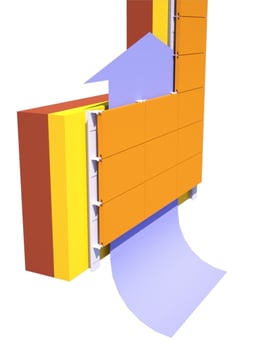Modern building construction has come a long way in terms of efficiency and durability. However, with the increased use of insulation and air-tight construction, the risk of moisture intrusion and the ability to allow the assemblies to dry out has become a significant concern. This is where rainscreen systems come into play.
“Rainscreen” is a term for the creation of an air gap between the backside of the siding and the weather resistive barrier (WRB) that covers the wall sheathing on the building exterior that allows incidental water that leaks behind the siding to drain down and out quickly and provide airflow to aid in drying. In this article, we will explore what a rainscreen system is, why it is important, and how it can benefit your building.
History of Rainscreens
Even though modern buildings utilize and benefit more from the advantages that rainscreen systems provide, the use of rainscreens dates all the way back to the Middle Ages. In Norway, there is a stave church in Urnes, built around 1130, that has wooden rainscreen cladding that is still standing today.

More recently, research was done in the 1960s and 1970s to develop the rainscreen principles and types that are used today. As buildings were required to be tighter, more insulated, and increasingly built with cheaper and less durable materials, building defects and damage from water has increased. The need for a better way to manage water has become more necessary in modern, tighter, and more insulated buildings and is no longer considered a “Cadillac” repair, but a necessary part of an exterior wall system in most areas and especially areas known for rain.
What is a rainscreen system and how does it work?
The rainscreen gap provides a capillary break between the WRB and the siding which allows moisture to be redistributed by evaporation and diffusion. A rainscreen is a safety system for your walls to better deal with water over the life of the building and is like safety systems use modern vehicles like airbags, antilock brake, vehicle stability systems and automatic accident-avoidance systems. We hope we do not need those vehicle safety systems but are glad we have them when we need them. The rainscreen improves the siding system and gives the wall a safety factor for issues due to imperfect installation and age-related issues. There are three basic types of rainscreens:
- Drainage Rainscreen: Rainscreen cavity vented at the bottom only to provide drainage. Used on low rise buildings.
- Vented Rainscreen: Rainscreen with vented at the top and bottom of the wall to increase airflow and drying. Used on low-rise and mid-rise buildings.
- Pressure Equalized Rainscreen: Designed rainscreen system used to equalize wind pressure on sides of the cladding for higher wind conditions. Typically used on high rise or high wind buildings.
A rainscreen system can be created with various materials and will differ depending on the siding installed on the building. Anchored brick has long incorporated a rainscreen behind it to increase drainage and drying. “Plaster” type siding materials such as EFIS, stucco, and adhered masonry veneer set on a mortar bed will be installed on a drainage mat/plane whereas fiber cement, wood or metal panel siding will be installed on battens strips.

Battens can be a variety of products with wood or plastic furring strips being the most common. Manufactured metal or composite furring system are utilized on more mid to high rise buildings especially if exterior insulation is being installed. Insect screen is installed at the top and the bottom of the wall assembly allowing the passage of air and water but prevents insects or pests from making their homes in the walls.
Why is a rainscreen system important?
No wall is 100% waterproof — or at least, they do not stay that way as they age. Sealants and building materials break down over time and water will find its way behind the siding. When the siding is sandwiched against the weather barrier and wall, water that gets past the siding can find even the smallest of holes to wet the structural wall or overwhelm the waterproofing system during a storm. If the rate of wetting exceeds the rate of drying in the wall, over time, damage will happen. Providing an air and moisture path behind the siding allows the water to escape from behind the siding and provide drying of the structural wall and the siding. Moisture intrusion can have serious consequences for a building. It can lead to mold growth, peeling paint, rotting of wood, damage to interior finishes and other types of structural damage. These problems can be costly to repair and can also pose health risks to occupants. A rainscreen system incorporated into the building’s siding assembly can help to prevent these problems.
What are the benefits of a rainscreen system?
There are several benefits to using a rainscreen system, including:
- Lower cost: The rainscreen allows the siding system to perform better, limits water intrusion repairs, decreases maintenance costs, and increases the siding lifespan.
- The gap prevents moisture from being held against the weather resistive barrier allowing it to be redistributed, drain, or evaporate.
- The gap at the top and the bottom of the wall assembly provides a path for air to move allowing the wall to dry out quicker.
- A rainscreen system is hiding behind the siding providing an invisible layer of protection that does not compromise the aesthetic appeal of a building.
- Improved durability: A rainscreen system can help to protect the building from moisture intrusion, which can lead to structural damage and other problems.
- A rainscreen can reduce maintenance costs by allowing for a longer time between paintings due to the increased siding stability due to drying and less repairs needed due to water intrusion.
- Improved vapor control: Vapor escaping from the building has less restrictions to migrating to the exterior since it does not have to go through the siding.
- Improved indoor air quality: A rainscreen helps mitigate moisture related problems like water intrusion and vapor migration that could have affected the interior air quality over time.
- Increased energy efficiency: A rainscreen gap (vented top and bottom) decouples the siding from the building lowering the sun thermal heat transfer into the building and allows for venting the heat from behind the siding.
A rainscreen system is a vital component of modern building construction to give a safety system to better deal with water in all its forms, extend the lifespan of the siding, and lower the cost overall. It helps to protect buildings from moisture intrusion by removing moisture quicker than it can enter the building cavity. When designing a building, it is important to consider incorporating a rainscreen system to provide optimal safety protection from water and increase the longevity of the wall system.
Think a rainscreen system is right for your property? Schedule a free chat with us, and we'll help you figure it out.